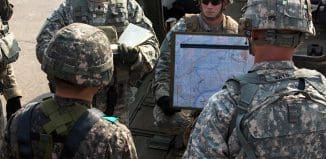Will ISIS Gain Hold of New Russian Weapons in Iraq?
This post is also available in:  עברית (Hebrew)
עברית (Hebrew)

The Iraqis are using a deadly weapon system against the Islamic State of Iraq and Syria (ISIS). This is the Russian-built TOS-1A multiple launch rocket system. It was reported last year that Russia was supplying such weapons and they appear to have been delivered in recent weeks.This according to Aviation week.
First deployed by Russia against Islamic mujaheddin in Afghanistan in the 1980s, but kept secret until the 1990s, the TOS-1A is unique. Based on a T-72 tank chassis, it carries 24 unguided 220-millimeter rockets with a range of 6 km. Each rocket can carry a 100 kg fuel-air-explosive (thermobaric) warhead and all 24 rockets can be salvoed in 12 seconds, placing 2.4 tonnes of FAE downrange.
The system’s short range, size and lack of guidance make it ineffective in manuever warfare, and FAE is not particularly useful against deployed and widely spread targets. Its original target was most likely Afghan rebels in caves and makeshift bunkers. It was a principal weapon in the battle of Grozny in 1999-2000. Today, it would be used against fortifications and in urban warfare and would be an ideal weapon if one’s military goal was to destroy forces in city tunnels and bunkers — and as long as the devastating injuries that it causes were of no consequence.
iHLS – Israel Homeland Security
FAE has no significant fragmentation effects. A precursor charge disperses the explosive — which may be liquid or slurry — into a cloud that then ignites: the weapon is powerful for its weight because the warhead weight is all fuel, with atmospheric air as the oxidizer. The warhead produces a powerful blast wave with a peak pressure of almost 30 times atmospheric pressure and temperatures as high as 3000 deg. C. The effects propagate through any bunker that is not hermetically sealed.
A U.S. Army report notes that body armor provides little protection against heat and overpressure. Outside the immediate blast zone, where victims are killed instantly, the blast wave is likely to cause internal injuries, particularly in fluid/body interfaces such as the lungs and gut, that cannot be easily diagnosed or stabilized by combat medical personnel.






























